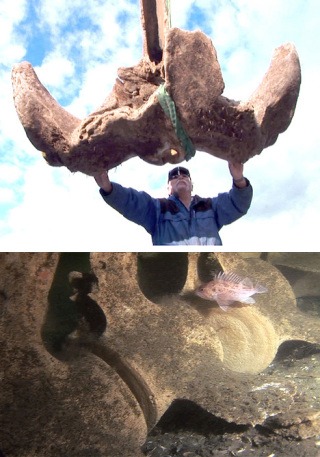The cranium of a whale skeleton that has been on the ocean bottom near the San Juan Islands since November 2006 finally resurfaced on June 1, after a long, exhausting weekend for a team of U.W. Friday Harbor Labs divers and vessel operators.
Bringing the 9 1/2-foot-long cranium of a large male fin whale to the surface was a precarious and challenging task. Divers spent two days preparing straps and lines before they were finally able to retrieve the large, unwieldy object and hoist it onto the deck of the Centennial, a U.W. research vessel. The other pieces of the skeleton, including two jaw bones, remain on the seafloor in the San Juan Islands.
According to Jim Kenagy, curator of mammals at the Burke, this procedure is a novel attempt to add to the museum’s mammalogy research collection, which already contains more than 50,000 specimens.
The 54-foot carcass was initially recovered near Everett in autumn 2006, after the animal had died from being struck by a large ship. The Burke Museum partnered with the University of Washington’s Friday Harbor Labs to employ an innovative method for preparing the skeleton.
In November 2006, the recovered whale was towed by the Centennial to the San Juan Islands. A research group, led by David Duggins of the Friday Harbor Labs, sank the carcass to a depth of about 120 feet. The whale remained on the bottom, where it naturally decomposed, for 18 months. This is the first Burke whale specimen to be obtained by these unusual means.
The sinking of the whale carcass provided marine scientists a special opportunity to investigate the natural process of decomposition and nutrient recycling that occurs on the ocean floor. Dr. Craig Smith of the University of Hawaii leads a team of researchers who track this ecological process.
On Sunday, the whale’s cranium was brought to the surface by a dive team led by U.W. diving safety officer Pema Kitaeff. The divers included San Juan Island resident Kurt Long and three others from Western Washington University’s Shannon Point Marine Center: Nate Schwarck, Karl Mueller and Robert C. Williams.
The U.W. Friday Harbor team has used a ROV (remotely operated vehicle), underwater photography and divers to document the complexity and dynamics of the ecological community that has benefited from the decomposition of the fin whale.
A short videocast of the footage, narrated by Kenagy, is available on the Burke Museum’s Web site. Click here.




